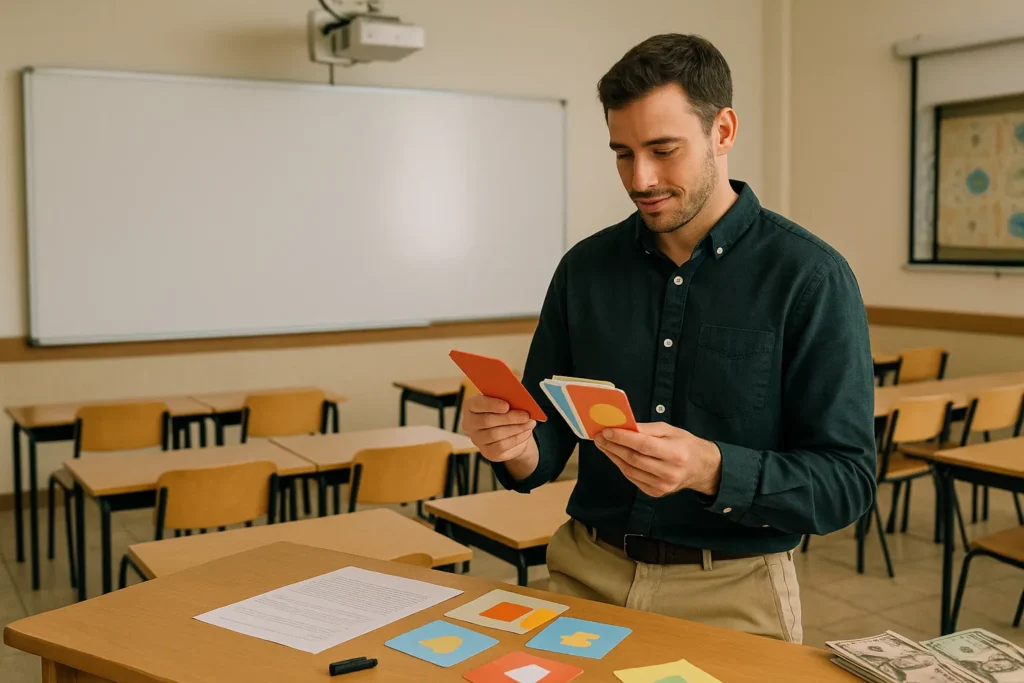Congratulations! You’ve landed your first teaching job abroad. But visas? Packing? What if your students laugh at your accent? Suddenly, you feel like “adventure” is a code word for “existential crisis”.
Truthfully, improvisation only works in movies. Real success comes from knowing how to handle paperwork without tears, what to pack, and how to integrate into different cultures. We’ll walk through all of these in our guide.
Ready to shake off your confusion and become truly excited about what lies ahead? Your future students deserve the best version of you (not the one who packed three winter coats for Dubai). Let’s get started.
Essential Teaching Abroad Preparation
Ah, paperwork, the thrilling prequel to your teaching adventure. Sure, sorting documents feels about as exciting as watching paint dry, but skip one form, and instantly you’re that person sobbing at immigration while your dream job says goodbye.

We’ve been fixing these “oops” moments since 1998 (back when people still used fax machines for this stuff). Trust us: nobody looks cool explaining why they can’t start teaching at their new school.
So grab a coffee, and tackle the two paperwork “must-dos” before you even think about packing that suitcase.
Moving for a Teaching Job: Visa and Docs
Let’s talk about the real MVPs of your teaching adventure: your documents. If you miss one paper, you’re not a teacher abroad. You’re just… abroad.
Here’s a checklist for you from the trenches:
- Official Papers: Passport? Check. Birth certificate? Check. Transcripts that prove you graduated? Double-check. Now go and play expiration date bingo. If anything’s expiring within six months, renew it now. Your future self will high-five you at immigration.
- Visa Process: Research your specific visa category and application requirements, like it’s the final exam you forgot to study for. Every country has different timelines and requirements, so you must be sure about these two things.
- Apostille/Legalisation: What? The paperwork for your paperwork? Well, nobody said it’d be simple. But this authentication drama can take weeks, and government offices dance to their slow-motion rhythm. That’s why you should start early unless you enjoy last-minute panic attacks.
Validating Your TEFL Certification
TEFL (Teaching English as a Foreign Language) certification proves you’re qualified to teach English to non-native speakers. Its accreditation status will make or break your teaching abroad plans.
If you forget to complete this step, you could be stuck explaining to immigration why your “qualification” from “World’s Best Online TEFL (Guaranteed!)” doesn’t meet their standards.
Non-negotiable TEFL checks for you:
- Minimum course hours (usually 120+ hours for accredited programmes).
- In-person teaching practice (required in many EU and Middle Eastern countries).
- Country-specific registrations (like South Africa’s SACE or Qatar’s MOE approval).
These checks will be the difference between walking into your new classroom and getting escorted to the departure lounge. Your choice.
Pro tip: The British Council’s TEFL accreditation database is your first stop for verification. Then you need to cross-reference with your target country’s education ministry website.
Because trusting a PDF from a random provider is how teaching dreams become deportation stories.
Managing Enough Money Overseas
The overseas teaching salary won’t extend as far when you’re paying international bank fees and emergency visa extension costs. The teachers who last are always money-savvy enough to survive month three when the “adventure” wears off and reality bites.

We’ll now break down how you can build that financial safety net.
Initial Savings and Budgeting
Let’s be brutally honest. Your teaching contract won’t pay you for at least a month (likely longer). Flights cost you more with baggage, while visas bleed you dry with hidden fees, and landlords will demand shocking advance deposits from you.
What’s the sweet point then? How much do you need to save before stepping into the airport?
Your rule of thumb is triple your estimated living cost, because when your phone gets stolen or you need an emergency dentist, “living cheaply” won’t cut it.
If checking your bank balance after setup costs makes your stomach drop, delay your departure and take more prep. You need real savings for teaching abroad since it’s a professional relocation.
So, bring enough money to survive three months, or risk joining the graveyard of teachers who flew home broke.
Unexpected Costs and Local Finances
The feeling of “fresh start” evaporates when you pay 15% exchange fees or find that your new landlord only accepts local bank transfers. That’s why you need to open a bank account immediately. Most countries require proof of address (a utility bill or rental contract) and employment paperwork.
You should also never exchange large sums at airports. Rather, use Wise or local bureaus for better rates. And set aside an emergency fund in both currencies since foreign ATMs love to fail during emergencies.
Beware of utility companies, too. They often demand huge deposits from foreigners. And that “quick trip home” for a family emergency costs triple when booked at the last minute.
Prepare for everything.
Pro tip: Use services from banks that have English-speaking staff. Financial stress increases when your queries and explanations are not understood. “Lost in translation? More like lost in financial frustration!”, as Michael Scott would say while trying to open a bank account abroad.
Cultural Insight for Teaching Abroad
You know that awkward moment when you accidentally offend someone and have no idea what you did wrong? Multiply that by every day for months, and you’ll understand why cultural preparation matters.

You need to research local etiquette as if your job depended on it (because it does). Master classroom hierarchies, religious sensitivities and social taboos before you need to apologise for breaking them.
Here’s some advice. Just observe everything for two weeks before implementing your “brilliant” new teaching style (what works in Leeds might horrify in Dubai).
Understanding Local Customs
In parts of the Middle East, that cheerful thumbs-up you give students is the equivalent of flipping them off, so you need to be careful.
In fact, the way you handle a business card in Japan or discuss weekend plans in conservative communities isn’t as simple as you think.
Successful teachers learn curriculum requirements, yes, but they study local customs with the same intensity as their lesson plans. Before you arrive in your destination country, don’t forget to research offending gestures, gift-giving etiquette, and conversation boundaries.
Workplace Culture Differences
Schools operate by unwritten cultural rules that make no sense until they do. For example, if you turn up five minutes late in Germany, you’ve insulted the staff. The headteacher in South Korea expects formal deference, while in Australia, they might insist you call them “mate”.
Everyone’s feedback styles reveal even more about them. Your Dutch colleagues will bluntly say your lesson was garbage. And Japanese staff might tell you “interesting approach” when they mean “never do that again”.
But no, these cultural differences aren’t restricted to mannerisms. They’re the invisible framework that holds the education system together.
Basic Local Language Skills
A few basic phrases in the local language can prove you’re ready to show effort rather than just being another clueless foreigner. That’s why when you greet their child with broken language, parents love that and smile. Shopkeepers also want to help you instead of shrugging you off.
And the best part of it all is that students secretly respect your effort, even when you butcher the pronunciation.
Don’t wait anymore. Download Duolingo today (it’s better to get used to the owl’s threat now), join a language exchange tomorrow, and watch how “Sorry, my language is terrible” becomes your most charming quality.
Classroom Preparation for Your Teaching Job
If you step into your first overseas classroom without enough preparation, it’ll be like moving through a foreign city without a map. You might eventually find your way, but not without unnecessary struggles (we think nobody wants to be the teacher equivalent of a lost tourist).
That’s the reason behind prepared teachers feeling more confident and connecting with students faster. Proper preparation means you can concentrate more on teaching and not try to figure out what works.

We’ll now share some strategies on taking your classroom prep.
Early Lesson Planning
Your first day arrives, and suddenly you’re staring at thirty faces who don’t know you and might not understand your accent. But if you have a backup plan for your backup plans, you’ll find it easier to handle uncertain moments.
Here are three ideas for you to begin your classroom journey with:
- First Week Ideas: You can use ice-breakers that work across cultures. So prepare some adaptable and engaging introductory activities to build connections and assess student levels quickly. For instance, Guess the Dream is a good ice-breaking game where students say two truths and one wish, the class guesses which one’s the fake.
- Basic Resources: Technology always fails, and you should be ready for it by bringing versatile teaching materials and digital tools to your classroom. E.g., flash cards, basic games, and offline apps can be your lifesavers.
- Curriculum Review: Before you arrive at the school, familiarise yourself with the school’s general subject outlines and learning objectives. It’ll help you adjust your teaching style to your school’s expectations.
Teach English: Useful Strategies
What if your students expect you to lecture for fifty minutes straight, but you’re used to interactive group work? Learn to be flexible, my friend. Because you wouldn’t know anything about your students’ learning preferences at first, and this is something that varies dramatically between cultures.
We have some preparation suggestions for you. Find and research some classroom management techniques that are common in your destination country. However, you should be mindful that some students expect formal, lecture-style teaching, while others flourish with interactive, discussion-based approaches.
Adjust your style to their preferences accordingly and take it from there.
What to Expect Teaching Overseas
You might have lesson plans perfected down to the minute, but what about the actual test? We’re talking about how your teaching expertise means nothing if you’re crying into your instant noodles every night. Homesickness doesn’t care how many degrees you have, and your perfect grammar doesn’t impress cultural shock.
Here’s the truth that they don’t put in brochures: Everything that happens when you’re not in the classroom matters as much as your teaching effort, since overseas teaching is rarely limited to your whiteboard. That’s why it’s important to focus on improving instead of just surviving between bells.

Let’s fix that. We’re building your real survival kit: the support systems, the coping tricks, and the unglamorous but vital stuff that makes you go “I’ve got this!” rather than “I’m struggling”.
Building Social Connections
That first staff room coffee clutch is a special kind of lonely, isn’t it? You’re standing there like a lost tourist at a train station, while everyone else chats in their pre-formed groups. Newsflash! Making friends as an adult is harder than it was in primary school.
Expat Lifelines
Facebook groups are the modern-day watering holes for professionals abroad. You can simply search “You_City_Name Expats” and watch your social calendar fill up. Plus, international school staff rooms double as accidental support groups for people trying to understand the local scenery.
Forced Socialisation Works
Sign up for anything with a sign-up sheet. Language classes? Yes. Volunteer litter picking? Surprisingly effective. Badminton club full of retirees? Now you’ve got everyone’s grandparents and… cardio.
It’s also important to appear approachable to others (make it easier for them to show interest in you). Never dress like a person who’s scouting for someone to help you move furniture.
Pro Tip: Download Meetup and pretend you’re swiping for friends instead of dates. Yeah, the same awkward small talk, but lower stakes. Your early interactions will feel as natural as a giraffe on roller skates, but soon you’ll have people to complain about the weather with. That’s expat friendship gold.
Ask us how we know.
Staying Connected with Home
Let’s start with homesickness. When you’re 8,000 miles away from home, you miss your mum’s Sunday roast or your best mate’s terrible jokes the most. It’s perfectly fine, you know. But you should learn to manage it well to prevent it from overwhelming your teaching adventure.
The Keep-In-Touch Cheat Sheet
Schedule video calls like they’re staff meetings (but with more laughing at Dad’s failed attempts to use the mute button). Share photos of your new life so aggressively that your family starts recognising your students by name. And yes, remember, watching Coronation Street with a VPN is self-care.
Comfort Food Hacks
That local dish looks suspiciously like something your cat coughed up? Pair it with a stash of your favourite biscuits from home. Your new colleagues don’t need to know you cried into a Jaffa Cake at 3 pm. Cultural integration has limits. Respect it.
Laugh Through the Pain
When the language barrier makes your pharmacy visit an accidental mime performance, accept the experience. Then send the dramatic retelling to your mates back home immediately. You get bonus points if you describe the cashier’s horrified expression in extreme detail.
And don’t feel guilty about watching local telly sometimes. You may find yourself laughing out loud at the protagonist getting a death threat (everything’s comedy if you don’t understand the language). But who cares?
Ready to Make Your Move?
Teaching abroad changes both your work and your life, but the success of your job depends highly on your careful preparation. Expert teachers don’t leave it to Lady Luck, so they plan strategically, prepare thoroughly, and stay open to new experiences.
In this article, we’ve covered important documentation, financial planning, cultural and classroom preparation, and building social connections for your first teaching job abroad. Our discussion provided practical steps to ensure your overseas teaching experience starts smoothly.
The question now is, are you ready to do it? Visit Mind Leap Tech and let our experienced team guide you through every step of your international teaching adventure.
